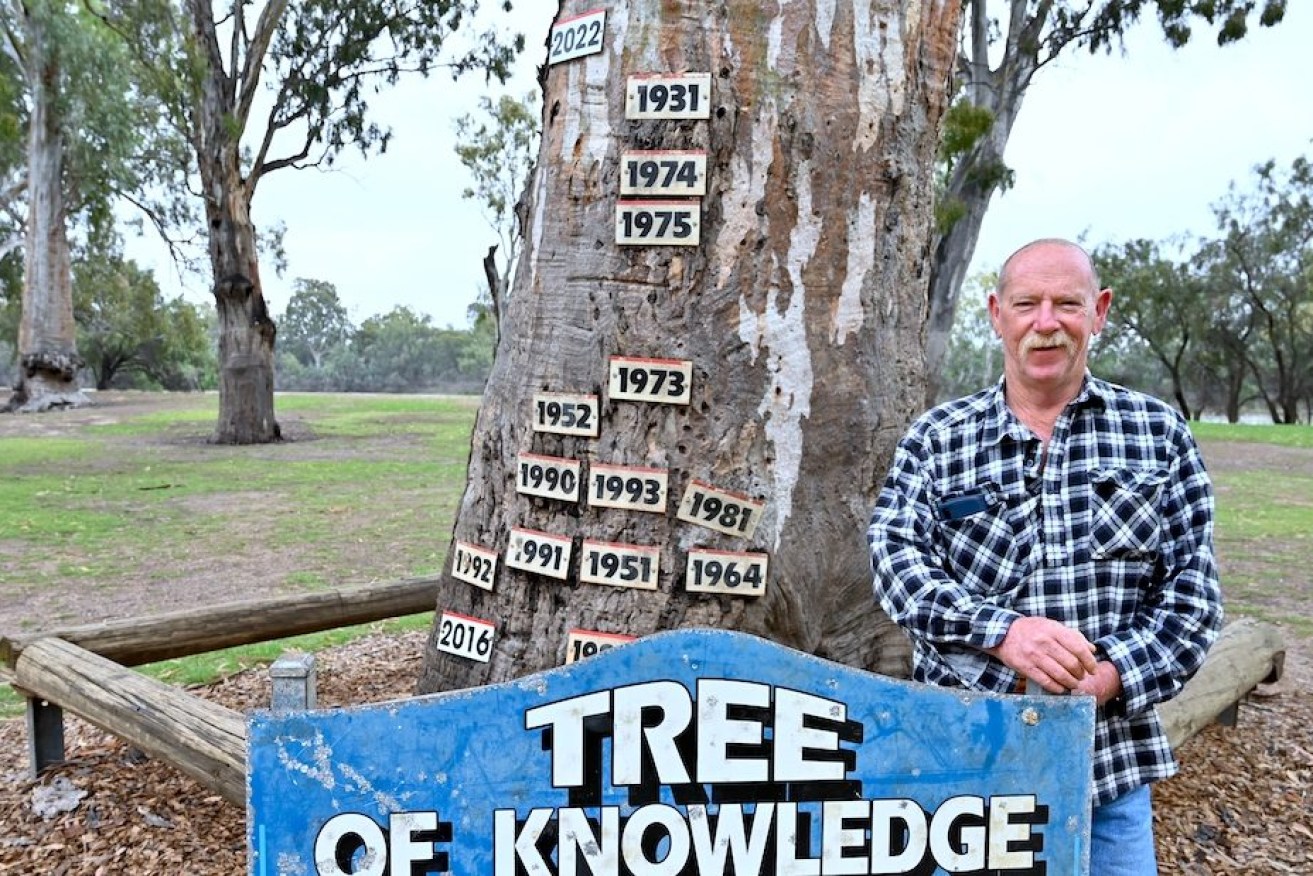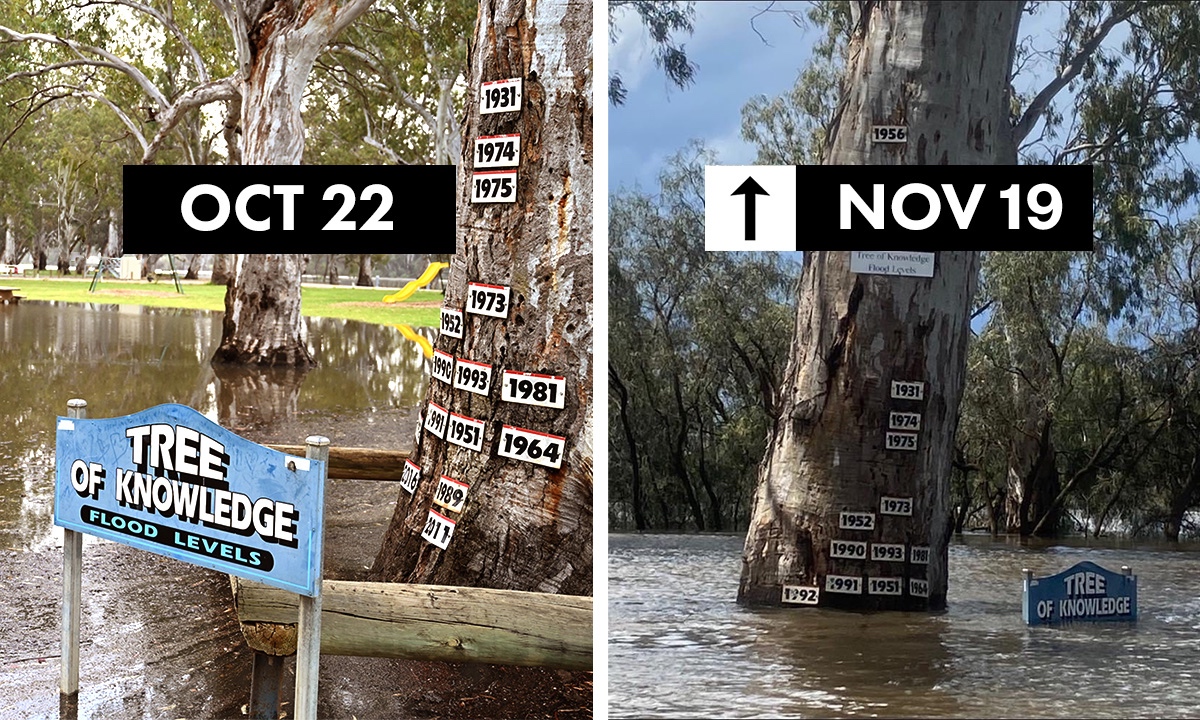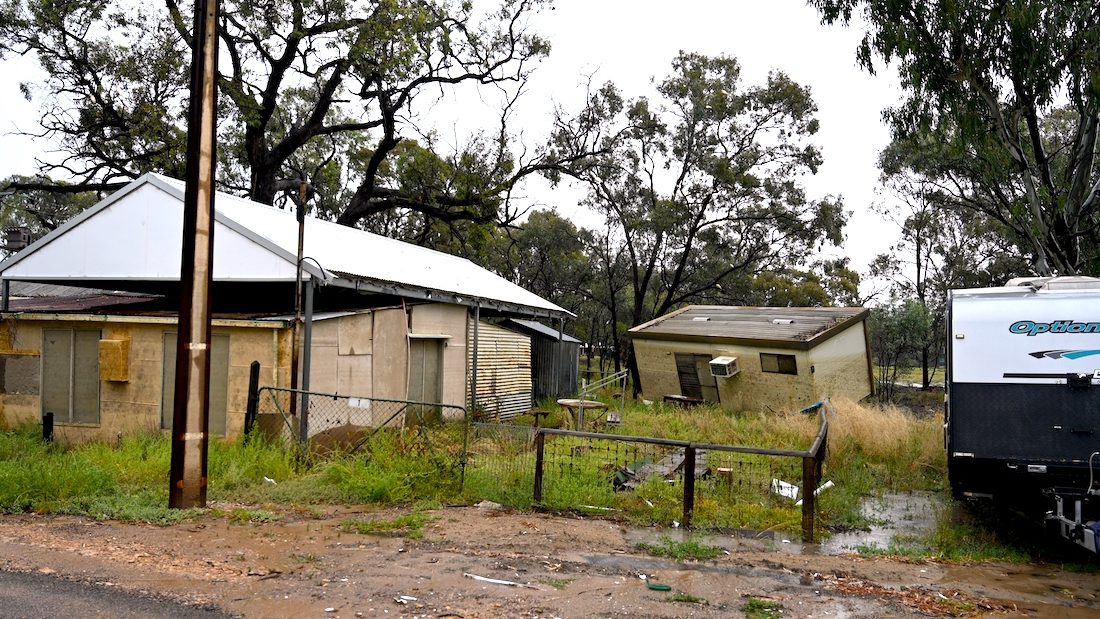Watermarks still blight towns one year after devastating River Murray floods
River Murray locals faced a very different Christmas season in 2022, as surging floodwaters threatened towns, forced evacuations and damaged or destroyed homes. A year on, InDaily visited some of the worst-affected zones to see how life in the region is getting back to “normal”.


Mining worker Peter Munday visits the Loxton "Tree of Knowledge" with its new sign recording the 2022 River Murray flood. Photo: Belinda Willis/InDaily
Alex Zimmerman is getting close to having clocked 60,000km travel since taking on the job overseeing South Australia’s recovery from River Murray floods which started bearing down on the state last November.
“It was my anniversary seven days ago,” the state’s Community Recovery Coordinator says, adding that he is still consumed with helping thousands of people struggling to repair their homes, businesses and state of mind.
This time last year, South Australians watched the mighty river continue to swell.
It peaked at 186 gigalitres of water coursing across the border from Victoria on December 22, the sheer force destroying holiday shacks and breaching levees in the Lower Murray to inundate dairy farms.
Houseboat operators tethered vessels usually booked out for the festive season and hoped for the best. Towns built barriers, some vineyards flooded and tourist businesses were brought to their knees as many visitors either cancelled bookings or could not access riverfront sites.
Caravan parks were among those that bore the brunt of high-water levels, with many still waiting to demolish amenity blocks and rebuild pools as they reopen for business.
An estimated 3500 homes were affected, and the mammoth task of rebuilding continues.
State Government data shows that so far almost 150,000 working hours have been spent on the clean-up, that includes removing 18,890 tonnes of rubbish from the region. About 60 tonnes of debris including washing machines, roofing and heavy logs were fished from the river itself.
Zimmerman says locals are getting on with the job of getting back to normal, as tourists return to book cabins, hotel rooms and houseboats for summer holidays and fill local dining rooms with festive season chatter.
The river lands are looking beautiful. There is new growth along the river banks and flood plains, numerous bird species are thriving and bright Christmas decorations line main shopping streets in towns built near the waterway.

River Murray water levels rising at the Loxton Tree of Knowledge last year.
Peter Munday was visiting the Tree of Knowledge on the riverbank at Loxton this week, along with two fellow workers from the Mindarie Murray Zircon mine.
“We came into town to stock up for a barbecue tonight and thought we’d come and have a look, now we are down here seeing it (the river) we’ve started talking about getting a houseboat,” says Munday, who has moved to SA from Western Australia.
The old river redgum gained fame during the flood as it recorded water climbing over other historical high-water dates from the past. Levels slowly but surely leapfrogged flood levels from 1952, then 1973, 1974 and 1931.
When the water was dangerously high near the tree, the Loxton Waikerie District Council continued to post regular pictorial updates via its social media sites.
At Waikerie, the riverfront barbecue areas and holiday park are bustling, and the ferry that was moved from its spot as water rose has long been returned, with little damage to its entry and exit ramps.
Council chief executive officer David Beaton says construction of a new community hub building is well underway at the river front football club – with its design “above the ’56 flood line”.
“This time last year there was something that the community shared in a sense, people were coming together and being understanding about that,” Beaton says.
“Whereas this year we’re getting back to normal, but it’s still not one hundred percent, there are still people doing it harder this Christmas and we’re trying to do what we can to help.”
It was the sheer grit of communities along the river banks and support of fellow South Australians showing their “Spring Gully moment” – a reference to when the state banded together in 2013 to buy products and save the struggling Spring Gully business – that Zimmerman remembers and continues to see most.
“The size of the flood was immense, there was a lot of effort going into sandbagging and it didn’t help, it was never going to help,” Zimmerman says.
So, when the call went out for tourists to support towns like those in the Riverland and Mannum where some businesses were forced to close, Zimmerman was heartened to see South Australians arrive to spend locally in droves.
“People were really rallying together, it’s that sense of community that makes it all worthwhile,” he says.
“It’s still there. One of the challenges with recovery is that long-term resilience and how do you retain that strong sense of community.”
It was not until February this year that the flood was officially declared over.
Almost 2000 people registered for clean-up assistance and 150 homes have been demolished for free under a state government scheme, but there are several hundred more on the waiting list.

A river shack in Blanchetown this week that has been destroyed by River Murray flooding. Photo: Belinda Willis/InDaily
As water receded, it was shack or home owners stretching from Morgan to Mannum that emerged most affected.
Zimmerman says rebuilds are proving to be complex as owners wait on insurance assessments, face new planning guidelines for homes near the water’s edge with better flood design resilience and a shortage of contractors and materials.
Some owners were under-insured or had no insurance cover at all – and all over the region there are many struggling with the overwhelming task ahead.
His team is continuing to support those communities.
Recovery centres still operate in Mannum and Murray Bridge and continual programs from the state’s Rising Up for Our River travel voucher campaign to community sausage sizzles are being funded by the State Government.
Mannum Waters Marina held a “remainers celebration picnic” last month as they “worked to stay afloat”, while yoga classes have been held at Bowhill and Mannum.
Gardening expert Sophie Thomson is hosting workshops in Mannum and Swan Reach in December to help guide locals in creating appropriate new gardens.
Zimmerman says he is acutely aware that recovery it is not just about fixing buildings and businesses.
The long-term mental health of those affected must be continually addressed, with many still experiencing the stress of either losing homes or businesses, or still facing that threat.
He tells of shack owners feeling guilt about the family holiday spot passed down through generations that was destroyed on their watch – and about a man discovered living unknown in a caravan near the river banks for 15 years.
“Unfortunately, this man was dealing with mental health and physical health issues, he had no means of transport and has no family members at all… we were able to link him into help with doctors and other health professionals,” Zimmerman says.
And, the former SA police inspector who was also involved in the Pinery and Cudlee Creek bushfire response, is determined to continue supporting those in need.
“I suppose early in the piece people ran on the proverbial adrenalin dealing with an incredible event in our time … then insidiously, it creeps in, we hear more of people becoming very emotional, they come into the recovery centres and we can see all the issues are so much to bear,” he says.
“It was almost like a war zone in some of those places immediately after the flood, there was immense destruction.
“My mantra is I can’t guarantee a particular outcome but I can absolutely guarantee 200 per cent effort to get a good result.”




